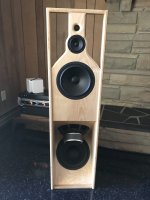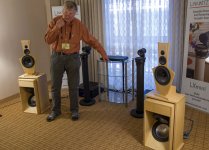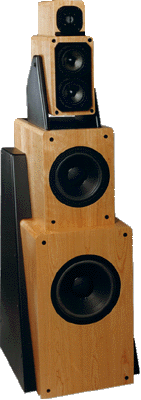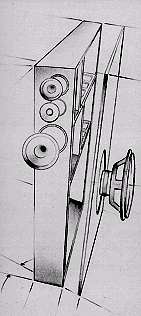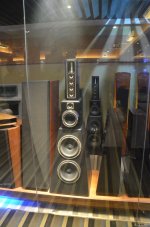I listened to a lot of speakers, and those i like all have wide baffles and large boxes. It's not scientific at all, but as this is a constant factor in wich speakers i like, i tend to use that in my speakerbuilds. I've red all kind of theories of both camps of this discussion (wide vs small baffle), and see no real consensus or scientific proof that "the other" is wrong, so i think it's a case of what you prefer, both have advantages and disadvantages.
But i prefer wide baffles, so that is what i build...
But i prefer wide baffles, so that is what i build...
The ratio folklore to fact on this subject is enormous. There seems to be little solid evidence for either side of the debate. I started out accepting the common wisdom that narrow baffles are superior (this is the more common position). Then, in attempting to develop a flagship product for a small company, we were slowly drawn over a number of years (iteration to iteration) to the wide-baffle camp.Absence of evidence is not evidence of absence, as they say. What is the quality and quantity of evidence supporting the opposite take, ie:wide baffle better? Thanks for the insight and opinion, I find it fascinating.
An interesting experiment is to attend an audio show, listen to 20 or 30 small-footprint speakers, and then listen to something like the Voxativ Ampeggio Due.
How would a large baffle covered with felt, to mitigate edge diffraction, compare?
Today, Fine Tuning?
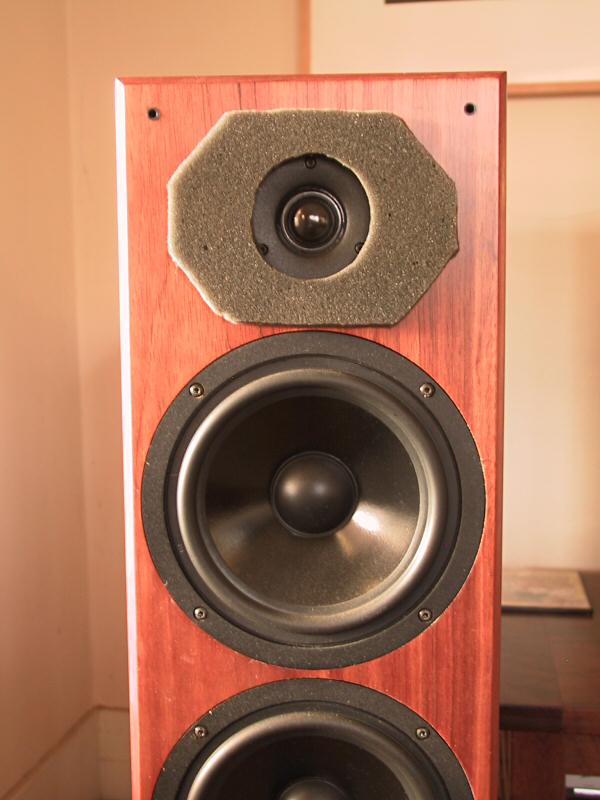
Put the felt or high density foam around the tweeter. I used foam on my old Von Schweikert VR2 speakers because that is what I had. It made a big difference.
I have enjoyed and admired both large and small baffle speakers, but yes there is a certain quality that stems from the baffle size. Large baffle speakers have a common sonic fingerprint that somehow transcends the easily measured qualities of frequency response and horizontal dispersion. The same is true for small baffle speakers.
What I hear with large baffle speakers is a more realistic presentation of sound from about 100 Hz to 400 Hz. Male voice, piano, electric guitar and bass, and the larger brass and woodwind instruments (trombone, baritone sax) seem more immediate and real. I have no idea why this perception exists even among speakers with very different tonal balances.
Most small baffle speakers seem to disappear more easily when I close my eyes. They seem more 3 dimensional. I use to think that this was a by-product of the fact that small narrow speakers were easier to place in the ideal location within the room, but I think it goes beyond that... even when placed in a non-optimum location, they still seem to create a believable 3 dimensional sonic illusion.
Obviously we all have preferences in what we value most in reproduced sound. I also believe we differ in how we perceive sound particularly music. Further, we all live in different rooms, and our speaker choices are heavily influenced by the room in which we live.
What I hear with large baffle speakers is a more realistic presentation of sound from about 100 Hz to 400 Hz. Male voice, piano, electric guitar and bass, and the larger brass and woodwind instruments (trombone, baritone sax) seem more immediate and real. I have no idea why this perception exists even among speakers with very different tonal balances.
Most small baffle speakers seem to disappear more easily when I close my eyes. They seem more 3 dimensional. I use to think that this was a by-product of the fact that small narrow speakers were easier to place in the ideal location within the room, but I think it goes beyond that... even when placed in a non-optimum location, they still seem to create a believable 3 dimensional sonic illusion.
Obviously we all have preferences in what we value most in reproduced sound. I also believe we differ in how we perceive sound particularly music. Further, we all live in different rooms, and our speaker choices are heavily influenced by the room in which we live.
Covering the baffle with heavy felt or foam can have a positive benefit, if the tonal balance is adjusted... i.e. you will loose a little HF response with a felt/foam baffle (maybe 1 db more or less), so if you adjust the response of the tweeter up appropriately, you will probably find an improvement. Vandersteen and Wilson have used this technique for decades.
I have never heard a convincing theory for why felt/foam covered baffles would make the kind of improvement that we hear. The "first cut" analysis would predict no real benefit, yet that is not what most people hear.
I have never heard a convincing theory for why felt/foam covered baffles would make the kind of improvement that we hear. The "first cut" analysis would predict no real benefit, yet that is not what most people hear.
to me, that example in that link looked more like driver beaming effect then baffle size effect.
try the ripple tank applet, it is fun to use. add a wall and place the sound source at it. try different sizes and increase the freq
Ripple Tank Simulation
try the ripple tank applet, it is fun to use. add a wall and place the sound source at it. try different sizes and increase the freq
Ripple Tank Simulation
To a first approximation, the edges of your baffle are also sound sources (with a delay and opposite polarity compared to the direct sound). The amount of delay is dependent on the width of the baffle. When the delay is small compared to the period of the signal, the response is uniform in space. To put it another way, speakers become omnidirectional below the baffle step. Above the baffle step frequency, the sound sources will interfere differently at different angles. Thus wide baffle speakers (assuming no edge treatments) have interference patterns across a wider bandwidth than narrow baffle speakers do.
Interestingly, if you want uniform sound throughout your room, without interference, the baffle surrounding a driver should always be small compared to the wavelengths produced by that driver.
Interestingly, if you want uniform sound throughout your room, without interference, the baffle surrounding a driver should always be small compared to the wavelengths produced by that driver.
The link did not work for me...
Anyway, I was thinking, we all know the picture, like the look from the top of the baffle, where tweeter is in the middle of the baffle, and waves are emanating from the center, and once waves reach the edge of the baffle, diffraction happens, especially if the edge is sharp, so the picture shows more new waves (not good) coming from the edge...everyone knows this. Everyone knows rounding of the edges is important.
But I have the gut feeling there is more to it. High frequencies bounce of the flat surfaces. While in above mentioned pictures, there is nothing showing in between the tweeter and the edge happening, what if there is some bounce going on. I have no data on this, just a gut feeling. Hence if the baffle is minimal, less bounce, off course, even minimal baffle is rounded. Both SL LX521 and Nao Note II have minimal baffles, yet rounded, and both measure impeccably well, both on axis and off axis. Its a pity Nao Note pages are down, I remember there were some nice polars presented.
Both speakers image well.
Anyway, I was thinking, we all know the picture, like the look from the top of the baffle, where tweeter is in the middle of the baffle, and waves are emanating from the center, and once waves reach the edge of the baffle, diffraction happens, especially if the edge is sharp, so the picture shows more new waves (not good) coming from the edge...everyone knows this. Everyone knows rounding of the edges is important.
But I have the gut feeling there is more to it. High frequencies bounce of the flat surfaces. While in above mentioned pictures, there is nothing showing in between the tweeter and the edge happening, what if there is some bounce going on. I have no data on this, just a gut feeling. Hence if the baffle is minimal, less bounce, off course, even minimal baffle is rounded. Both SL LX521 and Nao Note II have minimal baffles, yet rounded, and both measure impeccably well, both on axis and off axis. Its a pity Nao Note pages are down, I remember there were some nice polars presented.
Both speakers image well.
Attachments
Musicanndesign.com is here now, new server
Original Offerings
about baffle dimensions etc. basics
Tech
Original Offerings
about baffle dimensions etc. basics
Tech
The baffle does support sound as it travels outward. As it happens this sound was mainly travelling in this direction (the baffle leads from the source), so they are working together.But I have the gut feeling there is more to it. High frequencies bounce of the flat surfaces.
true, all true, but somehow people still make slim boxes around mids and tweets for reason
this is from web...
Many people who do their own speaker projects separate the woofer from the rest of the system, putting it in its own box. Often, people also bi-amp the system, using a separate amplifier for the woofers. This greatly simplifies crossover construction and gives you more control over bass. The mid and tweeter should be at roughly the ear level of the listener (when sitting) so that the sound doesn't seem to come from above or below. You could build a box that was 4 feet tall. This just means more work and wood, but build the speaker you want. It is cheaper and simpler to build a large sub box with a separate much smaller bookshelf sized speaker. Another option which is very popular with manufacturers is to make a single, thin, deep box with a side firing woofer, as in the NHT 3.3 above. The front of the box is just wide enough to fit the mid and tweeter, and the box is just deep enough to fit the woofer on the side. The necessary volume for the woofer comes from the box's height, which is tall enough to allow the mid and tweeter to be at ear level. Since the box is thin, there is no wasted area (or wood) in the box. NHT, Klipsch, and Definitive Technologies are a few of the companies that design speakers like this.
this is from web...
Many people who do their own speaker projects separate the woofer from the rest of the system, putting it in its own box. Often, people also bi-amp the system, using a separate amplifier for the woofers. This greatly simplifies crossover construction and gives you more control over bass. The mid and tweeter should be at roughly the ear level of the listener (when sitting) so that the sound doesn't seem to come from above or below. You could build a box that was 4 feet tall. This just means more work and wood, but build the speaker you want. It is cheaper and simpler to build a large sub box with a separate much smaller bookshelf sized speaker. Another option which is very popular with manufacturers is to make a single, thin, deep box with a side firing woofer, as in the NHT 3.3 above. The front of the box is just wide enough to fit the mid and tweeter, and the box is just deep enough to fit the woofer on the side. The necessary volume for the woofer comes from the box's height, which is tall enough to allow the mid and tweeter to be at ear level. Since the box is thin, there is no wasted area (or wood) in the box. NHT, Klipsch, and Definitive Technologies are a few of the companies that design speakers like this.
Attachments
The baffle does support sound as it travels outward. As it happens this sound was mainly travelling in this direction (the baffle leads from the source), so they are working together.
there is likely some drag as the molecules propagate the wave by bouncing to each other
Musicanndesign.com is here now, new server
Original Offerings
about baffle dimensions etc. basics
Tech
Thanks! good to know, lot of useful info.
Here is a quote from Dr Geddes recently. The subject was regarding the texture of a wall for which a sound wavefront was travelling normal to.there is likely some drag as the molecules propagate the wave by bouncing to each other
The normal mode will barely see any wall texture since its wave is propagating at a grazing incidence, which "is widely known" that this means little to no effect on the wave. This is certainly true if the texture is small compared to a wavelength. Hence for this mode virtually nothing happens.
- Status
- This old topic is closed. If you want to reopen this topic, contact a moderator using the "Report Post" button.
- Home
- Loudspeakers
- Multi-Way
- Benefits of minimal baffle
